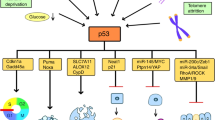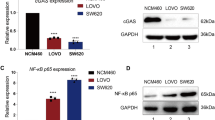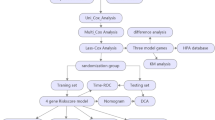Abstract
The targeted expression of transgenes is one of the principal goals of gene therapy, and it is particularly relevant for the treatment of brain tumors. In this study, we examined the effect of the overexpression of human gas1 (growth arrest specific 1) and human p53 cDNAs, both under the transcriptional control of a promoter of the human glial fibrillary acidic protein (gfa2), employing adenoviral expression vectors, in glioma cells. We showed that the targeted overexpression of gas1 and p53 (AdSGas1 and AdSp53, respectively) in rat glioma cells (C6) reduced the number of viable cells and induced apoptosis. Moreover, the adenovirally targeted expression of these genes also reduced tumor growth in vivo. Unexpectedly, there was no additive effect when both gas1 and p53 were simultaneously expressed in the same cells using a bicistronic adenoviral vector. We suggest that Gas1 does not act in combination with p53 in the C6 and U373 glioma cell lines, inducing apoptosis and cell cycle arrest. Our results indicate that the targeted expression of tumor suppressor genes (gas1 and p53) regulated by the gfa2 promoter, together with adenoviral vectors may provide an interesting approach for adjuvant selective glioma gene therapy.
This is a preview of subscription content, access via your institution
Access options
Subscribe to this journal
Receive 12 print issues and online access
$259.00 per year
only $21.58 per issue
Buy this article
- Purchase on SpringerLink
- Instant access to full article PDF
Prices may be subject to local taxes which are calculated during checkout






Similar content being viewed by others
References
Lopez-Gonzalez MA, Sotelo J . Brain tumors in Mexico: characteristics and prognosis of glioblastoma. Surg Neurol 2000; 53: 157–162.
Maher EA, Furnari FB, Bachoo RM, Rowitch DH, Louis DM, Cavenee WK et al. Malignant glioma: genetics and biology of a grave matter. Genes Dev 2001; 15: 1311–1333.
Barzon L, Zanusso M, Colombo F, Palu G . Clinical trials of gene therapy, virotherapy, and immunotherapy for malignant gliomas. Cancer Gene Ther 2006; 13: 539–554.
Lawler SE, Peruzzi PP, Chiocca EA . Genetic strategies for brain tumor therapy. Cancer Gene Ther 2006; 13: 225–233.
Stebel M, Vatta P, Ruaro ME, Del Sal G, Parton RG, Schneider C . The growth suppressing Gas1 product is a GPI-linked protein. FEBS Lett 2000; 481: 152–158.
DelSal G, Ruaro EM, Utrera R, Cole CN, Levine AJ, Schneider C . Gas1-induced growth suppression requires a transactivation-independent P53 function. Mol Cell Biol 1995; 15: 7152–7160.
Lee KKH, Leung AKC, Tang MK, Cai DQ, Schneider C, Brancolini C et al. Functions of the growth arrest specific 1 gene in the development of the mouse embryo. Dev Biol 2001; 234: 188–203.
DelSal G, Ruaro ME, Philipson L, Schneider C . The growth arrest-specific gene, Gas1, is involved in growth suppression. Cell 1992; 70: 595–607.
Mellstrom B, Cena V, Lamas M, Perales C, Gonzalez C, Naranjo JR . Gas1 is induced during and participates in excitotoxic neuronal death. Mol Cell Neurosci 2002; 19: 417–429.
Zamorano A, Lamas M, Vergara P, Naranjo JR, Segovia J . Transcriptionally mediated gene targeting of Gas1 to glioma cells elicits growth arrest and apoptosis. J Neurosci Res 2003; 71: 256–263.
Zamorano A, Mellstrom B, Vergara P, Naranjo JR, Segovia J . Glial-specific retrovirally mediated Gas1 gene expression induces glioma cell apoptosis and inhibits tumor growth in vivo. Neurobiol Dis 2004; 15: 483–491.
Lang FF, Bruner JM, Fuller GN, Aldape K, Prados MD, Chang S et al. Phase I trial of adenovirus-mediated P53 gene therapy for recurrent glioma: biological and clinical results. J Clin Oncol 2003; 21: 2508–2518.
Martins CP, Brown-Swigart L, Evan GI . Modeling the therapeutic efficacy of P53 restoration in tumors. Cell 2006; 127: 1323–1334.
Ventura A, Kirsch DG, McLaughlin ME, Tuveson DA, Grimm J, Lintault L et al. Restoration of P53 function leads to tumour regression in vivo. Nature 2007; 445: 661–665.
Benitez JA, Segovia J . Gene therapy targeting in the central nervous system. Curr Gene Ther 2003; 3: 127–145.
Segovia J, Vergara P, Brenner M . Astrocyte-specific expression of tyrosine hydroxylase after intracerebral gene transfer induces behavioral recovery in experimental parkinsonism. Gene Therapy 1998; 5: 1650–1655.
Vandier D, Rixe O, Brenner M, Gouyette A, Besnard F . Selective killing of glioma cell lines using an astrocyte-specific expression of the herpes simplex virus thymidine kinase gene. Cancer Res 1998; 58: 4577–4580.
Vandier D, Rixe O, Besnard F, Kim M, Rikiyama T, Goldsmith M et al. Inhibition of glioma cells in vitro and in vivo using a recombinant adenoviral vector containing an astrocyte-specific promoter. Cancer Gene Ther 2000; 7: 1120–1126.
Sacchettoni SA, Benchaibi M, Sindou M, Belin MF, Jacquemont B . Glutamate-modulated production of GABA in immortalized astrocytes transduced by a glutamic acid decarboxylase-expressing retrovirus. Glia 1998; 22: 86–93.
Holland EC, Varmus HE . Basic fibroblast growth factor induces cell migration and proliferation after Glia-specific gene transfer in mice. Proc Natl Acad Sci USA 1998; 95: 1218–1223.
Do Thi NA, Saillour P, Ferrero L, Dedieu JF, Mallet J, Paunio T . Delivery of GDNF by an E1, E3/E4 deleted adenoviral vector and driven by a GFAP promoter prevents dopaminergic neuron degeneration in a rat model of Parkinson's disease. Gene Therapy 2004; 11: 746–756.
Eng LF, Ghirnikar RS, Lee YL . Glial Fibrillary acidic protein: GFAP-thirty-one years (1969–2000). Neurochem Res 2000; 25: 1439–1451.
He TC, Zhou SB, da Costa LT, Yu J, Kinzler KW, Vogelstein B . A simplified system for generating recombinant adenoviruses. Proc Natl Acad Sci USA 1998; 95: 2509–2514.
Baker SJ, Markowitz S, Fearon ER, Willson JK, Vogelstein B . Suppression of human colorectal carcinoma cell growth by wild-type P53. Science 1990; 249: 912–915.
Attal J, Theron MC, Houdebine LM . The optimal use of IRES (internal ribosome entry site) in expression vectors. Genet Anal 1999; 15: 161–165.
Ghattas IR, Sanes JR, Majors JE . The encephalomyocarditis virus internal ribosome entry site allows efficient coexpression of 2 genes from a recombinant provirus in cultured-cells and in embryos. Mol Cell Biol 1991; 11: 5848–5859.
Choi-Lundberg DL, Bohn MC . Ontogeny and distribution of glial cell line-derived neurotrophic factor (GDNF) MRNA in rat. Brain Res Dev Brain Res 1995; 85: 80–88.
Garcia-Tovar CG, Perez A, Luna J, Mena R, Osorio B, Aleman V et al. Biochemical and histochemical analysis of 71 KDa dystrophin isoform (Dp71f) in rat brain. Acta Histochem 2001; 103: 209–224.
He TC, Zhou SB, da Costa LT, Yu J, Kinzler KW, Vogelstein B . A simplified system for generating recombinant adenoviruses. Proc Natl Acad Sci USA 1998; 95: 2509–2514.
Houdebine LM, Attal J . Internal ribosome entry sites (IRESs): reality and use. Transgenic Res 1999; 8: 157–177.
Gu J, Andreeff M, Roth JA, Fang B . HTERT promoter induces tumor-specific Bax gene expression and cell killing in syngenic mouse tumor model and prevents systemic toxicity. Gene Therapy 2002; 9: 30–37.
Gu J, Zhang LD, Huang XF, Lin TY, Yin M, Xu K et al. A novel single tetracycline-regulative adenoviral vector for tumor-specific Bax gene expression and cell killing in vitro and in vivo. Oncogene 2002; 21: 4757–4764.
Leung YF, Tam PO, Lee WS, Lam DS, Yam HF, Fan BJ et al. The dual role of dexamethasone on anti-inflammation and outflow resistance demonstrated in cultured human trabecular meshwork cells. Mol Vis 2003; 9: 425–439.
Lee CS, Buttitta L, Fan CM . Evidence that the WNT-inducible growth arrest-specific gene 1 encodes an antagonist of sonic hedgehog signaling in the somite. Proc Natl Acad Sci USA 2001; 98: 11347–11352.
Schueler-Furman O, Glick E, Segovia J, Linial M . Is GAS1 a co-receptor for the GDNF family of ligands? Trends Pharmacol Sci 2006; 27: 72–77.
Cabrera JR, Sanchez-Pulido L, Rojas AM, Valencia A, Manes S, Naranjo JR et al. Gas1 is related to the glial cell-derived neurotrophic factor family receptors alpha and regulates ret signaling. J Biol Chem 2006; 281: 14330–14339.
Mograbi B, Bocciardi R, Bourget I, Busca R, Rochet N, Farahi-Far D et al. Glial cell line-derived neurotrophic factor-stimulated phosphatidylinositol 3-kinase and Akt activities exert opposing effects on the ERK pathway – importance for the rescue of neuroectodermic cells. J Biol Chem 2001; 276: 45307–45319.
Song H, Moon A . Glial cell-derived neurotrophic factor (GDNF) promotes low-grade Hs683 glioma cell migration through JNK, ERK-1/2 and P38 MAPK signaling pathways. Neurosci Res 2006; 56: 29–38.
Wiesenhofer B, Weis C, Humpel C . Glial cell line-derived neurotrophic factor (GDNF) is a proliferation factor for rat C6 glioma cells: evidence from antisense experiments. Antisense Nucleic Acid Drug Dev 2000; 10: 311–321.
Shintani T, Klionsky DJ . Autophagy in health and disease: a double-edged sword. Science 2004; 306: 990–995.
Lum JJ, Bauer DE, Kong M, Harris MH, Li C, Lindsten T et al. Growth factor regulation of autophagy and cell survival in the absence of apoptosis. Cell 2005; 120: 237–248.
Yu LY, Jokitalo E, Sun YF, Mehlen P, Lindholm D, Saarma M et al. GDNF-deprived sympathetic neurons die via a novel nonmitochondrial pathway. J Cell Biol 2003; 163: 987–997.
Kanzawa T, Kondo Y, Ito H, Kondo S, Germano I . Induction of autophagic cell death in malignant glioma cells by arsenic trioxide. Cancer Res 2003; 63: 2103–2108.
Paglin S, Hollister T, Delohery T, Hackett N, McMahill M, Sphicas E et al. A novel response of cancer cells to radiation involves autophagy and formation of acidic vesicles. Cancer Res 2001; 61: 439–444.
Ruaro EM, Collavin L, DelSal G, Haffner R, Oren M, Levine AJ et al. A proline-rich motif in P53 is required for transactivation-independent growth arrest as induced by Gas1. Proc Natl Acad Sci USA 1997; 94: 4675–4680.
GomezManzano C, Fueyo J, Kyritsis AP, Steck PA, Roth JA, McDonnell TJ et al. Adenovirus-mediated transfer of the P53 gene produces rapid and generalized death of human glioma cells via apoptosis. Cancer Res 1996; 56: 694–699.
Asai A, Miyagi Y, Sugiyama A, Gamanuma M, Ilhong S, Takamoto S et al. Negative effects of wild-type P53 and S-Myc on cellular growth and tumorigenicity of glioma-cells – implication of the tumor-suppressor genes for gene-therapy. J Neurooncol 1994; 19: 259–268.
Vanmeir EG, Roemer K, Diserens AC, Kikuchi T, Rempel SA, Haas M et al. Single-cell monitoring of growth arrest and morphological-changes induced by transfer of wild-type P53 alleles to glioblastoma cells. Proc Natl Acad Sci USA 1995; 92: 1008–1012.
Chen XB, Ko LJ, Jayaraman L, Prives C . P53 levels, functional domains, and DNA damage determine the extent of the apoptotic response of tumor cells. Genes Dev 1996; 10: 2438–2451.
Liu G, Parant JM, Lang G, Chau P, Chavez-Reyes A, El Naggar AK et al. Chromosome stability, in the absence of apoptosis, is critical for suppression of tumorigenesis in Trp53 mutant mice. Nat Genet 2004; 36: 63–68.
Kane LP, Shapiro VS, Stokoe D, Weiss A . Induction of NF-KappaB by the Akt/PKB kinase. Curr Biol 1999; 9: 601–604.
Ryan KM, Ernst MK, Rice NR, Vousden KH . Role of NF-KappaB in P53-mediated programmed cell death. Nature 2000; 404: 892–897.
Fujioka S, Schmidt C, Sclabas GM, Li Z, Pelicano H, Peng B et al. Stabilization of P53 is a novel mechanism for proapoptotic function of NF-KappaB. J Biol Chem 2004; 279: 27549–27559.
Bredesen DE, Mehlen P, Rabizadeh S . Apoptosis and dependence receptors: a molecular basis for cellular addiction. Physiol Rev 2004; 84: 411–430.
Bordeaux MC, Forcet C, Granger L, Corset V, Bidaud C, Billaud M et al. The RET proto-oncogene induces apoptosis: a novel mechanism for hirschsprung disease. EMBO J 2000; 19: 4056–4063.
Chen WY, Bailey EC, McCune SL, Dong JY, Townes TM . Reactivation of silenced, virally transduced genes by inhibitors of histone deacetylase. Proc Natl Acad Sci USA 1997; 94: 5798–5803.
Ho IA, Hui KM, Lam PY . Glioma-specific and cell cycle-regulated herpes simplex virus type 1 amplicon viral vector. Hum Gene Ther 2004; 15: 495–508.
Morelli AE, Larregina AT, Smith-Arica J, Dewey RA, Southgate TD, Ambar B et al. Neuronal and glial cell type-specific promoters within adenovirus recombinants restrict the expression of the apoptosis-inducing molecule Fas ligand to predetermined brain cell types, and abolish peripheral liver toxicity. J Gen Virol 1999; 80 (Part 3): 571–583.
Wang CY, Li F, Yang Y, Guo HY, Wu CX, Wang S . Recombinant baculovirus containing the diphtheria toxin a gene for malignant glioma therapy. Cancer Res 2006; 66: 5798–5806.
Adachi Y, Chandrasekar N, Kin Y, Lakka SS, Mohanam S, Yanamandra N et al. Suppression of glioma invasion and growth by adenovirus-mediated delivery of a bicistronic construct containing antisense UPAR and sense P16 gene sequences. Oncogene 2002; 21: 87–95.
Deng WG, Kawashima H, Wu G, Jayachandran G, Xu K, Minna JD et al. Synergistic tumor suppression by coexpression of FUS1 and P53 is associated with down-regulation of murine double minute-2 and activation of the apoptotic protease-activating factor 1-dependent apoptotic pathway in human non-small cell lung cancer cells. Cancer Res 2007; 67: 709–717.
Green NK, McNeish IA, Doshi R, Searle PF, Kerr DJ, Young LS . Immune enhancement of nitroreductase-induced cytotoxicity: studies using a bicistronic adenovirus vector. Int J Cancer 2003; 104: 104–112.
Huang Y, Tyler T, Saadatmandi N, Lee C, Borgstrom P, Gjerset RA . Enhanced tumor suppression by a P14ARF/P53 bicistronic adenovirus through increased P53 protein translation and stability. Cancer Res 2003; 63: 3646–3653.
Wiesenhofer B, Stockhammer G, Kostron H, Maier H, Hinterhuber H, Humpel C . Glial cell line-derived neurotrophic factor (GDNF) and its receptor (GFR-Alpha 1) are strongly expressed in human gliomas. Acta Neuropathologica 2000; 99: 131–137.
Mullor JL, Altaba ARI . Growth, hedgehog and the price of GAS. Bioessays 2002; 24: 22–26.
Altaba ARI, Stecca B, Sanchez P . Hedgehog-Gli signaling in brain tumors: stem cells and paradevelopmental programs in cancer. Cancer Lett 2004; 204: 145–157.
Oliver TG, Wechsler-Reya RJ . Getting at the root and stem of brain tumors. Neuron 2004; 42: 885–888.
Acknowledgements
We thank Dr B Vogelstein (Johns Hopkins University) for providing us with the reagents (pAdEasy system) to construct the adenoviral vectors. The p53 plasmid (pC53-SN3) was kindly provided by Dr A Gutiérrez (Centro Nacional de Rehabilitación), and the β-actin antibody was a gift from Dr M Hernández (Cinvestav). We thank R Sánchez for laboratory assistance. This work was partially supported by a CONACyT grant 42721-M (JS).
Author information
Authors and Affiliations
Corresponding author
Rights and permissions
About this article
Cite this article
Benítez, J., Arregui, L., Vergara, P. et al. Targeted-simultaneous expression of Gas1 and p53 using a bicistronic adenoviral vector in gliomas. Cancer Gene Ther 14, 836–846 (2007). https://doi.org/10.1038/sj.cgt.7701076
Received:
Revised:
Accepted:
Published:
Issue date:
DOI: https://doi.org/10.1038/sj.cgt.7701076
Keywords
This article is cited by
-
Gas1 up-regulation is inducible and contributes to cell apoptosis in reactive astrocytes in the substantia nigra of LPS and MPTP models
Journal of Neuroinflammation (2016)
-
GAS1 is present in the cerebrospinal fluid and is expressed in the choroid plexus of the adult rat
Histochemistry and Cell Biology (2016)
-
Gas1 is present in germinal niches of developing dentate gyrus and cortex
Cell and Tissue Research (2016)
-
The Internalization of Neurotensin by the Low-Affinity Neurotensin Receptors (NTSR2 and vNTSR2) Activates ERK 1/2 in Glioma Cells and Allows Neurotensin-Polyplex Transfection of tGAS1
Cellular and Molecular Neurobiology (2015)
-
GAS1 induces cell death through an intrinsic apoptotic pathway
Apoptosis (2012)



